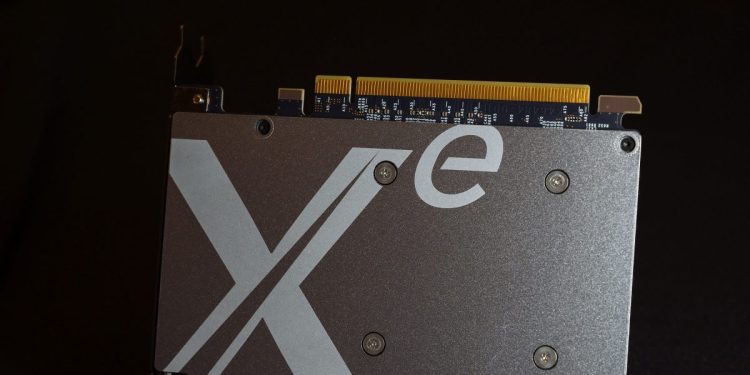Watch all the Transform 2020 sessions on-demand here.
Details about Intel’s Xe graphics platform continue to trickle out, albeit slower than we’d like. During a web briefing with reporters yesterday, Intel reiterated that Xe is shipping in three flavors — Xe-LP, Xe-HP, and Xe-HPC — targeting use cases like machine learning, transcoding, gaming, and high-performance computing. It also disclosed a performance metric on Tiger Lake, its next-generation processor architecture, and announced the DG1 (Discrete Graphics 1) Software Development Vehicle (SDV), a Xe product in a PCIe form factor that will enable developers to optimize for both Xe and Tiger Lake.
Xe
As previously revealed, Xe isn’t a one-size-fits-all sort of deal. There’s the Xe-LP and Xe-HP, which are optimized for low power envelopes and high performance, respectively, and a datacenter and supercomputing microarchitecture called Xe-HPC.
Xe-LP encompasses integrated graphics solutions, with a design that draws around 20 watts of power and potentially up to 50 watts. As opposed to X-HPC, which delivers compute upwards of teraflops (where a “teraflop” is equal to one million million operations per second), Xe-LP reaches petaflop-level performance (one thousand million million operations per second)
Xe-HPC will feature high cache bandwidth and unified coherent memory, plus support for data types including INT8, BF16, and FP16 (up to a 32 times vector rate). That’s courtesy of a custom data-parallel vector matrix engine that speeds up AI inference tasks while reducing power draw, much like Nvidia’s Tensor Cores. Intel is claiming a 40 times increase in double precision floating point (a number format representing a range of numeric values) performance per execution unit — that is, the independent programmable computational units within Xe.
June 5th: The AI Audit in NYC
Join us next week in NYC to engage with top executive leaders, delving into strategies for auditing AI models to ensure fairness, optimal performance, and ethical compliance across diverse organizations. Secure your attendance for this exclusive invite-only event.
Xe-HPC’s cache — Rambo — slots between the Xe’s memory and execution units, enabling it to achieve up to three times the memory’s bandwidth. Foveros, Intel’s high-performance three-dimensional integrated circuit technology, enables the integration of components manufacturing on different processes, complementing Xe’s XeMF memory fabric that scales up to thousands of execution units.
It’s a lot to keep straight, but here’s what’s important: DG1, the Xe form factor Intel revealed this week at the 2020 Consumer Electronics Show, has begun shipping to vendors globally via the DG1 SDV, which is built on Xe-LP. Intel next hopes to build Xe-HPC — code-named Ponte Vecchio — into Aurora, the supercomputer it is developing with Cray for the Department of Energy’s Argonne National Laboratory in Chicago. In the Aurora setup, Xe Link — an interconnect based on the standards laid out by the CXL consortium, whose members include AMD and Nvidia — will link six Ponte Vecchio Xe graphics cards per individual node.
Tiger Lake
Intel revealed earlier this week that Tiger Lake, the processor architecture based on its third-generation 10-nanometer process node (10nm++), will offer up to twice the graphics performance of Ice Lake, the product family it’s slated to replace. Today, the chipmaker got a bit more specific: Consumers can expect “double digit” performance gains from 10th Gen Intel Core (Ice Lake) to 11th Gen Intel Core (Tiger Lake).
Intel showed the DG1 SDV running the game Warframe but declined to reveal the game’s settings. Quite possibly, it was the same demo shown by Intel’s Lisa Pearce during the keynote on Monday, which also included a run of Destiny 2 at 1080p locked at 60 frames per second. (It’s worth noting that the keynote demo was a discrete DG1 chip inside a laptop, as opposed to a DG1 card or Tiger Lake integrated Xe graphics.)
As you’ll recall, Tiger Lake packs Intel Willow Cove processor cores and a graphics core containing up to 96 execution units, with some processors relying on a discrete DGX1. It supports PCI Express 4.0 and Thunderbolt 4 (which offers four times the throughput of USB 3), as well as LPDDR5 memory and extensions for AI model training acceleration.
Tiger Lake is slated to include quad-core 9-watt and 25-watt models, a handful of which will power the laptops released this year under Project Athena. That’s Intel’s specification requiring PCs to meet benchmarks for launching, boot time, system wake-up, power, performance, and more.
Graphics Command Center beta
Apropos of nothing, Intel noted that it recently launched a beta program for Graphics Command Center, a console through which various aspects of the company’s discrete and integrated hardware can be customized. It ships with a streamlined design and a help option that simplifies terms like “tessellation” and “anisotropic filtering,” as well as features like hardware-accelerated screen capture, upscaling for retro games with pixel art, combined desktop, and a shortcut to a topical Discord server.








